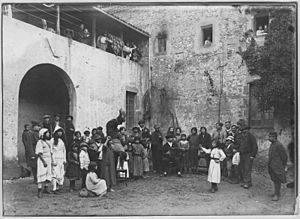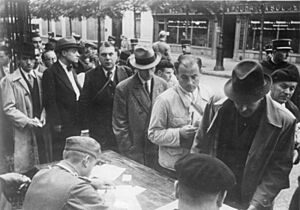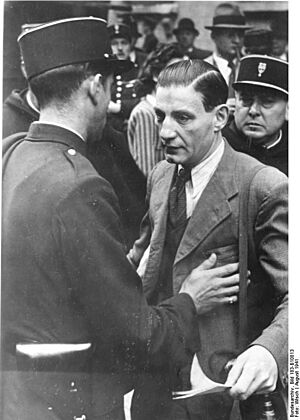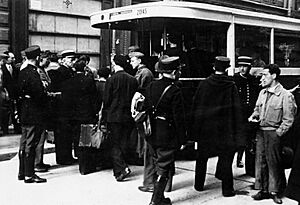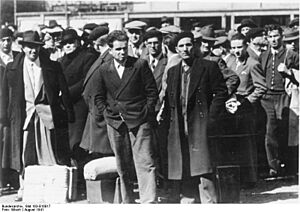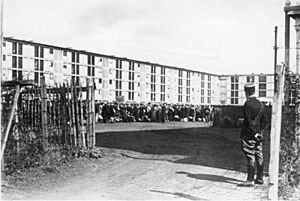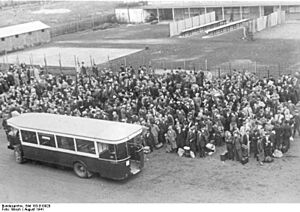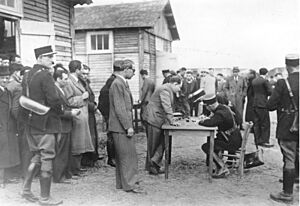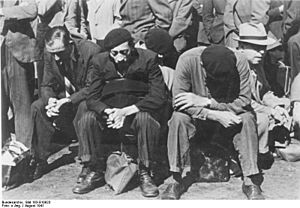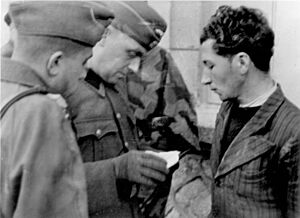Internment camps in France facts for kids
Internment camps are places where people are held against their will, often during times of war or political unrest. France had many such camps before, during, and after World War II. Before the war, some camps held German, Austrian, and Ottoman civilians during World War I. Later, the French government opened camps for Spanish people who were escaping the Spanish Civil War (1936–1939). These camps also held French Communists, a political group that was banned at the time. Even Germans who were against the Nazi regime were held there.
After 1940, when Marshal Philippe Pétain took power and created the Vichy regime, these camps were used to hold Jews, Gypsies, and people who were against fascism. The Vichy government opened so many camps that it created many jobs. Most of these camps closed after France was freed at the end of World War II. However, some were used during the Algerian War (1954–1962) to hold Algerians who had fought for France, known as harkis. Later, in the 1980s, camps like Camp de Rivesaltes and Bourg-Lastic held Kurdish refugees from Iraq.
Contents
Camps in World War I and Later
The first internment camps in France were set up during World War I (1914–1918). They held civilians from enemy countries, like Germany and Austria-Hungary. These camps were in places such as Pontmain, Fort-Barreaux, and Graveson.
Later, in the 1920s and 1930s, other camps held Armenians and Gypsies. For example, Gypsies were held in places like the Royal Saltworks at Arc-et-Senans and old industrial buildings.
Spanish Civil War Refugees

Before World War II, many camps were used for Spanish refugees. In just two weeks in early 1939, about 500,000 Spanish men, women, and children crossed the border into France. They were escaping the Spanish Civil War. Most of these refugees were held in camps in the Roussillon area, like the Camp de concentration d'Argelès-sur-Mer. Camps for Spanish refugees were set up all over France, even in the northwest.
Some of these camps included:
- Agde in the Hérault area.
- Argelès-sur-Mer, near the border.
- Camp Gurs in the Pyrénées-Atlantiques. This camp held different groups of Spanish refugees, including soldiers and farmers. Many were encouraged to return to Spain and were handed over to the new Spanish government.
- Camp Vernet near Pamiers.
- Moisdon-la-Rivière and Juigné-des-Moutiers in the Loire-Atlantique area.
- The Camp de Rivesaltes, where Jewish people were sent to Drancy internment camp, Gypsies to Saliers, and Spanish people to Camp Gurs.
In 1939, the Chilean poet Pablo Neruda helped 2,200 Spanish refugees from these camps travel to Chile on a ship called the Winnipeg.
After 1940, when Nazi Germany divided France, these camps also held Jews, Gypsies, and sometimes gay people. The original prisoners were forced to work to make the camps bigger.
Camps During World War II and the Vichy Regime
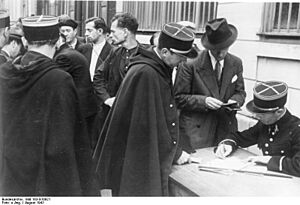
From 1939, existing camps were filled with Germans who were against the Nazis, including German Communists and German Jews. After France's defeat in 1940 and the start of the Vichy regime, these camps began holding Jews. First, foreign Jews were interned, then French Jews. The Vichy government gradually handed them over to the Gestapo, the Nazi secret police. Most of them passed through Drancy internment camp, which was the last stop before being sent to Nazi concentration camps and extermination camps in Germany and Eastern Europe.
Besides Jews, Germans and Austrians were also rounded up and sent to camps. Spanish refugees were also deported, and about 5,000 died in Mauthausen concentration camp. French colonial soldiers were held in France by the Germans instead of being deported.
The French government and the Vichy regime used different names for these places, like "reception camps" or "internment camps." The Vichy regime also created "transit camps," meaning the prisoners would be sent to Germany. Drancy and Pithiviers were examples of transit camps. Pithiviers was used in 1941 for a large roundup of Jews, and Drancy in 1942 for the Vel' d'Hiv Roundup.
One concentration camp created by the Nazis on French land was Struthof in Alsace. It had a gas chamber used to kill at least 86 prisoners, mostly Jewish. Their bodies were used for a Nazi professor's collection of skeletons.
Key Camps During World War II
Many camps were used during World War II. Here are some important ones:
- Aincourt: The first internment camp in Northern France, opened in October 1940 for French Communists.
- Royal Saltworks at Arc-et-Senans: Used to hold Gypsies.
- Bourg-Lastic: A former military camp where Jews were held. It later held Harkis in the 1960s and Kurdish refugees in the 1980s.
- Choisel, in Chateaubriant: Used from 1941 to 1942.
- Camp of Royallieu in Compiègne: Used from 1941 to 1944. Famous people like Robert Desnos and Jean Moulin passed through this camp.
- Drancy internment camp: Opened on August 20, 1941, when French police arrested over 4,000 Jews in Paris. It was guarded by French police and overseen by the Gestapo. It became the main transit camp for Jews being sent to extermination camps.
- Fort-Barraux: Had been a prison since the French Revolution.
- Gurs internment camp: Created in 1939 for Spanish refugees. During the war, it held Germans in France (including German Jews who had fled the Nazis), anti-military people, and French extreme-right sympathizers. Under Vichy, it held foreign Jews, Romani people, and stateless persons.
- Jargeau: Near Orléans, used for Romani people.
- Merignac internment camp: Where Jews from the Bordeaux region were held before being sent to Drancy.
- Camp des Milles: The largest internment camp in southeast France. About 2,500 Jews were deported from here in August 1942. Famous artists like Max Ernst were held here.
- Natzweiler-Struthof: A German-run concentration camp in the Vosges Mountains.
- Pithiviers transit camp: Jewish novelist Irène Némirovsky was held here.
- Fort de Romainville: A Nazi prison near Paris. Resistance members and hostages were sent here before being deported to concentration camps like Auschwitz. Many were also executed there.
- Saint-Cyprien: Held 90,000 Spanish refugees in March 1939.
- Saint-Sulpice-la-Pointe: This transit camp near Toulouse held people seen as a "danger to national security," mostly Communists. Later, it held foreign Jews. Many inmates were deported to camps in Eastern Europe.
- Saliers concentration camp: Near Arles, used to intern Romani people.
- Le Vernet Internment Camp: Held 12,000 Spanish refugees in 1939 and later held Harkis.
- Vittel: Used to intern US and British citizens.
Camps Under Foreign Control
The Nazis also opened Struthof in Alsace, which they had taken over. The United States military also had control over a camp in Septèmes-les-Vallons.
Ilags (German Civilian Internment Camps)
Ilags were internment camps set up by the German Army for Allied civilians. These included US citizens and British Commonwealth citizens caught in German-occupied areas.
- Besançon: Held about 2,400 British women in 1940. Many were later released or moved to Vittel.
- Saint-Denis: Near Paris, opened in June 1940. It held over 1,000 British men. Life was manageable due to Red Cross packages, a library, and sports.
- Vittel: Located in hotels in a spa town. Most British families and women were moved here. Some elderly people and children were released.
Colonial Administration Camps
The Vel' d'Hiv in Paris, a sports arena, was used during the July 1942 Roundup to hold Jews before they were sent to camps. It was also used during the Algerian War.
In French colonies like Algeria and Morocco, the Vichy government created forced labor camps for Jews. These were in places like Abadla, Bechar, and Bouarfa, Morocco.
After World War II
German Prisoners of War
After France was freed, camps were also used to hold German prisoners. For example, in Rennes, about 50,000 German prisoners were held in four camps after the city was liberated in 1944. In the Camp de Rivesaltes, German prisoners helped rebuild the area.
Post-War Refugees
Internment camps were used to receive French people from Indochina after the First Indochina War ended in 1954. About 9,000 Hungarian refugees also arrived after the 1956 uprising in Budapest. These refugees were held in various camps across France. Hungarian refugees were generally treated better than the French from Indochina.
Algerian War and Harkis
During the Algerian War (1954–1962), some camps were reopened in France to hold suspected Algerian independentists. In Algeria itself, the French administration moved up to 2 million civilians into "regrouping camps" to control them.
After the war officially ended in 1962, internment camps were used for the harkis, Algerians who had fought for France. Camps like Camp de Rivesaltes and Bourg-Lastic, which had held Jews during World War II, were used for Harkis in the 1960s and later for Kurdish refugees from Iraq in the 1980s.
Images for kids
See also
 In Spanish: Campos de internamiento en Francia para niños
In Spanish: Campos de internamiento en Francia para niños
- The Holocaust
- Collaboration with the Axis Powers


